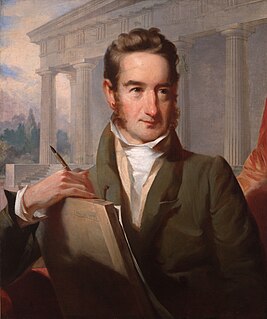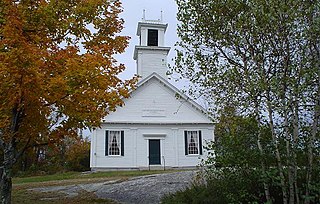
North Carolina is a state in the Southeastern region of the United States. The state is the 28th largest and 9th-most populous of the 50 United States. It is bordered by Virginia to the north, the Atlantic Ocean to the east, Georgia and South Carolina to the south, and Tennessee to the west. Raleigh is the state's capital and Charlotte is its largest city. The Charlotte metropolitan area, with an estimated population of 2,569,213 in 2018, is the most-populous metropolitan area in North Carolina, the 23rd-most populous in the United States, and the largest banking center in the nation after New York City. The Raleigh-Durham-Cary combined statistical area is the second-largest metropolitan area in the state, with an estimated population of 2,079,687 in 2019, and is home to the largest research park in the United States, Research Triangle Park.

Wilmington is a port city and the county seat of New Hanover County in coastal southeastern North Carolina, United States.

The National Association of Free Will Baptists (NAFWB) is a national body of Free Will Baptist churches in the United States and Canada, organized on November 5, 1935 in Nashville, Tennessee. The Association traces its history in the United States through two different lines: one beginning in the South in 1727 and another in the North in 1780. The "Palmer line," however, never developed as a formal denomination. It consisted of only about three churches in North Carolina. The NAFWB is the largest of the Free Will Baptist denominations.

Shaw University is a private Baptist historically black university in Raleigh, North Carolina, United States. Founded on December 1, 1865, Shaw University is the oldest HBCU to begin offering courses in the Southern United States. It has been called the "mother of the south in founding presidents of North Carolina Central University, Elizabeth City State University, and Fayetteville State University are all Shaw alumni. The founder of Livingstone College studied at Shaw, before transferring to Lincoln University. What became North Carolina Agricultural and Technical State University was located on Shaw's campus during its first year.

William Strickland, was a noted architect and civil engineer in Philadelphia, Pennsylvania, and Nashville, Tennessee. A student of Benjamin Latrobe and mentor to Thomas Ustick Walter, Strickland helped establish the Greek Revival movement in the United States. A pioneering engineer, he wrote a seminal book on railroad construction, helped build several early American railroads, and designed the first ocean breakwater in the Western Hemisphere. He was elected as a member of the American Philosophical Society in 1820.

The North Carolina Baptist Assembly is a Christian retreat owned and operated by the Baptist State Convention of North Carolina, the state's largest denomination. The grounds of the retreat, located adjacent to Caswell Beach on the eastern end of Oak Island, is the former site of Fort Caswell, a military base that was occupied by various branches of the U.S. armed forces for most of the period between 1836 and 1945. Most people still refer to the Baptist Assembly as Fort Caswell.

Gloria Dei Church, known locally as Old Swedes', is a historic church located in the Southwark neighborhood of Philadelphia, Pennsylvania, at 929 South Water Street, bounded by Christian Street on the north, South Christopher Columbus Boulevard on the east, and Washington Avenue on the south. It was built between 1698 and 1700, making it the oldest church in Pennsylvania and second oldest Swedish church in the United States after Holy Trinity Church in Wilmington, Delaware.

The 16th Street Baptist Church is a Baptist church in Birmingham, Alabama, United States. In 1963, the church was bombed by Ku Klux Klan members. The bombing killed four young girls in the midst of the Civil Rights Movement. The church is still in operation and is a central landmark in the Birmingham Civil Rights District. It was designated as a National Historic Landmark in 2006. Since 2008, it has also been on the UNESCO list of tentative World Heritage Sites.

Samuel Sloan was a Philadelphia-based architect and best-selling author of architecture books in the mid-19th century. He specialized in Italianate villas and country houses, churches, and institutional buildings. His most famous building—the octagonal mansion "Longwood" in Natchez, Mississippi—is unfinished; construction was abandoned during the American Civil War.

The Nathaniel Russell House is a historic house at 51 Meeting Street in Charleston, South Carolina, United States. Built in 1808 by wealthy merchant and slave trader Nathaniel Russell, it is recognized as one of America's most important neoclassical houses. It was designated a National Historic Landmark in 1973.

The former First Baptist Church is a historic Baptist church building located at 8601 Woodward Avenue in Detroit, Michigan. Built in 1909, it was designed by architect Guy J. Vinton in the Late Gothic Revival style. It is now the Peoples Community Church. The building was added to the National Register of Historic Places on August 3, 1982.

Bethesda Presbyterian Church is a historic church at 502 DeKalb Street in Camden, South Carolina. A National Historic Landmark, the main church building was built in 1822 and is one of few surviving churches designed by 19th-century American architect Robert Mills. The current minister is Rev. Jim Davis.

The High Hills of Santee, sometimes known as the High Hills of the Santee, is a long, narrow hilly region in the western part of Sumter County, South Carolina. It has been called "one of the state's most famous areas". The High Hills of Santee region lies north of the Santee River and east of the Wateree River, one of the two rivers that join to form the Santee. It extends north almost to the Kershaw county line and northeasterly to include the former summer resort town of Bradford Springs. Since 1902 the town has been included in Lee County.
Demographics of North Carolina covers the varieties of ethnic groups who reside in North Carolina and relevant trends.

This is a list of the National Register of Historic Places listings in Charleston County, South Carolina.

The Free Will Baptist Church is a historic church on Ridge Road in New Durham, New Hampshire. Built in 1819, it is considered the mother church of the Free Will Baptist movement, although it was not built until ten years after the death of founder Benjamin Randall. New Durham is where Randall rose to prominence, and where the church's teachings and governance were organized in 1780. The building was listed on the National Register of Historic Places in 1980.

Westport Town Hall is the current town hall of Westport, Maine. It is located on Main Road in a former Congregational church built in 1794. The building, used as the town hall since 1885, was listed on the National Register of Historic Places in 2002 as Union Meeting House, (Former) [sic].

Westbrook–Ardmore Historic District is a national historic district located at Wilmington, New Hanover County, North Carolina. The district encompasses 467 contributing buildings in a predominantly residential section of Wilmington. The district developed as six interrelated early-20th century subdivisions between about 1914 and 1956 and includes notable examples of Colonial Revival and Bungalow / American Craftsman style architecture. Notable buildings include St. Matthew's Evangelical Lutheran Church (1942), Central Church of Christ, Saint Mark Freewill Baptist Church, the Mills Store (1947), "English Cottage Style" former Pure Oil station (1936), and Art Moderne style Traveler's Service Station #3.

The Wilmington Historic District is a national historic district located at Wilmington, New Hanover County, North Carolina. The district encompasses 875 contributing buildings 38 contributing sites, and 3 contributing structures in the historic core and surrounding residential sections of Wilmington. The district developed after Wilmington was laid out in 1737, and includes notable examples of Queen Anne and Bungalow / American Craftsman style architecture. Located in the district are the separately listed City Hall/Thalian Hall and Alton Lennon Federal Building and Courthouse. Other notable buildings include:

Elizabeth City Historic District is a national historic district located at Elizabeth City, Pasquotank County, North Carolina. The district encompasses 592 contributing buildings, 1 contributing site, 1 contributing structure, and 1 contributing object in the central business district and surrounds residential sections of Elizabeth City. The district developed after 1789, and includes representative examples of Greek Revival, Federal, and Late Victorian style architecture. Notable contributing buildings include the Grice-Fearing House (1789-1808), Shirley Armstrong House, Goodman-Matthews-Pool House, Dr. William Martin House, Pool-Kennedy-Lumsden House, Charles-Hussey House, Richardson-Pool House, North Carolina Building (1859), Cobb Building, the former First Methodist Church, Christ Episcopal Church (1857), J. W. Dent House, Dr. Butt's Drug Store, the McMullen Building, the Lowrey Building, former Citizens Bank, Robinson Building (1903), Kramer Building (1909), Selig Building (1925), the Virginia Dare Hotel and Arcade (1927), First Baptist Church (1889), United States Post Office and Courthouse, and Pasquotank County Courthouse (1882).






















